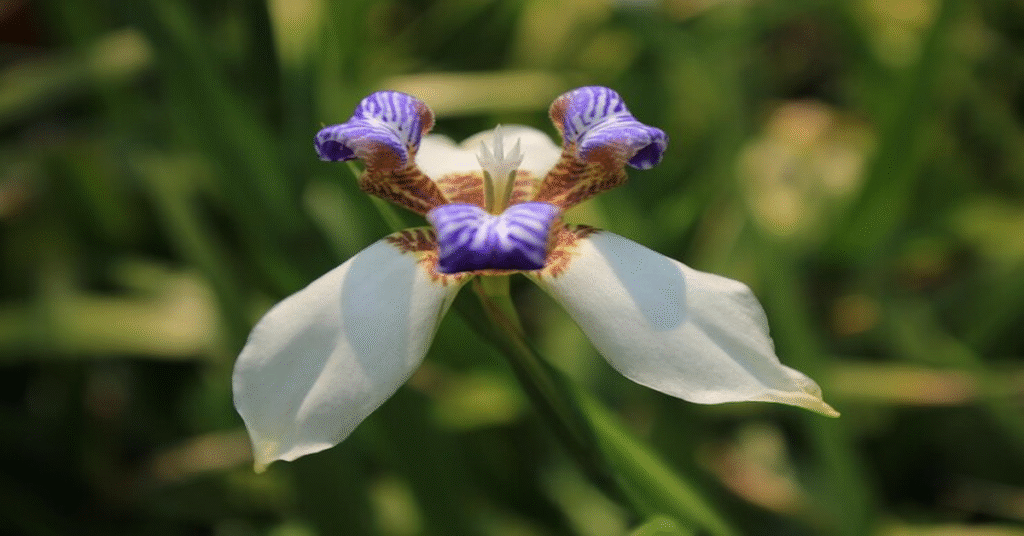The Iris flower is more than just a beautiful bloom. It carries centuries of symbolism, cultural significance, and botanical interest. Recognized for its intricate petals and vivid colors, the Iris stands as a perennial favorite among gardeners, florists, and historians alike.
Botanical Overview of the Iris
Classification and Genus
The Iris belongs to the family Iridaceae, comprising over 300 species. The name “Iris” is derived from the Greek word for rainbow, which accurately reflects the vast array of colors found in this genus. The genus includes rhizomatous and bulbous plants, most of which are native to the Northern Hemisphere, particularly Europe, Asia, and North America.
Physical Characteristics
Irises are known for their distinct fan-like foliage, sword-shaped leaves, and prominent blooms. The flowers typically consist of three upright petals (standards) and three hanging sepals (falls), which may be adorned with a “beard” or crest.
Depending on the species, the blooms may appear in early spring or even into summer, creating prolonged garden interest.
Varieties of Iris
There are numerous species and cultivars of Iris. Some of the most popular include:
- Iris germanica (Bearded Iris)
- Iris sibirica (Siberian Iris)
- Iris ensata (Japanese Iris)
- Iris reticulata (Dwarf Iris)
Each variety has its own unique attributes in terms of size, bloom shape, and preferred growing conditions.
History and Symbolism of the Iris
Historical Roots
The Iris has a rich history spanning many civilizations. In ancient Egypt, Irises were used in religious ceremonies and were often associated with royalty. The Greeks linked the flower to Iris, the goddess of the rainbow and a messenger of the gods. In France, the Iris evolved into the fleur-de-lis, a stylized emblem representing French monarchy and purity.
Symbolic Interpretations
The Iris is often associated with:
- Wisdom
- Hope
- Valor
- Faith
- Royalty
These meanings can vary slightly by color and cultural context. For example, a purple Iris often symbolizes royalty and wisdom, while a white Iris signifies purity and innocence.
Growth and Cultivation
Ideal Growing Conditions
Irises are generally hardy and adaptable. However, they flourish best under specific conditions:
- Soil: Well-drained, fertile soil; neutral to slightly acidic.
- Sunlight: Full sun to partial shade.
- Water: Moderate watering; overwatering can cause rhizome rot.
- Climate: Prefer temperate climates but some species tolerate cold or dry conditions.
Planting Techniques
Rhizomatous Irises
These types, such as Bearded Irises, should be planted with the top of the rhizome exposed to the air. Planting too deep can lead to rot. Fall is usually the best time for planting.
Bulbous Irises
Bulb Irises like Iris reticulata are typically planted in autumn, with bulbs placed 3–4 inches deep in well-draining soil.
Maintenance and Care
- Deadheading: Remove spent flowers to promote continued blooming.
- Dividing Rhizomes: Every 3–5 years, divide rhizomes to prevent overcrowding.
- Mulching: Use mulch in colder climates for winter protection.
- Fertilizing: Apply a low-nitrogen fertilizer in early spring and after blooming.
Popular Species of Iris
Iris Germanica (Bearded Iris)
Arguably the most iconic, Bearded Irises boast a fuzzy “beard” on their falls. They are prized for their ruffled blooms and are often the focal point of spring gardens.
Iris Siberica (Siberian Iris)
These are more delicate and slender than Bearded Irises, with grass-like foliage and refined, flat blooms. They are more tolerant of moisture and are suitable for wetland gardens.
Iris Ensata (Japanese Iris)
Known for their large, flat blooms and elegant appearance, Japanese Irises thrive in moist, acidic soil and bloom later in the season, extending the Iris display.
Iris Reticulata
This dwarf species is among the earliest to bloom, often peeking out through snow in late winter. It’s ideal for rock gardens and containers.
Iris in Art and Culture
Artistic Representation
Artists like Vincent van Gogh famously immortalized Irises in paintings. The flower’s unique structure and vibrant colors make it a favorite subject for botanical illustration and fine art.
Cultural References
In Japan, Irises are celebrated in art and poetry for their beauty and seasonal significance. In France, the fleur-de-lis remains a symbol of heritage, appearing in coats of arms, flags, and architectural motifs.
Iris in Modern Landscaping
Garden Design
Irises are ideal for border plantings, mass plantings, and water gardens. Their vertical form contrasts beautifully with rounded plants like peonies or ground covers such as creeping thyme.
Companion Plants
Good companions for Irises include:
- Daylilies
- Salvia
- Lupines
- Alliums
- Poppies
Combining textures and bloom times ensures a vibrant and diverse garden throughout the growing season.
Common Diseases and Pests
Diseases
- Rhizome Rot: Caused by overwatering or poor drainage. Treat by removing affected rhizomes and improving soil conditions.
- Leaf Spot: Fungal infection resulting in brown spots. Apply fungicides as needed.
- Rust: Appears as orange powdery spots; improve air circulation and remove affected foliage.
Pests
- Iris Borer: Larvae burrow into rhizomes, causing rot. Dig out and destroy infected parts.
- Aphids: Small insects that feed on sap. Use insecticidal soap or neem oil.
- Slugs and Snails: Especially damaging to young shoots. Apply barriers or organic slug bait.
Propagation Techniques
By Division
This is the most common method. Dig up the rhizome clump, cut healthy segments with at least one fan of leaves, and replant them.
By Seed
While more time-consuming, growing Irises from seed can be rewarding. It may take 2–3 years for flowering. Best used for developing new hybrids or for species that are difficult to divide Iris Flower.
Seasonal Care Guide
Spring
- Fertilize with balanced feed.
- Remove mulch and prune dead foliage.
- Watch for early pests.
Summer
- Deadhead and remove fading flowers.
- Water during dry spells.
- Avoid fertilizing late in the season.
Fall
- Divide overcrowded clumps.
- Cut foliage to about 6 inches.
- Prepare beds for winter by mulching lightly.
Winter
- In colder climates, protect with mulch.
- Avoid watering unless dry.
- Inspect for signs of rot or disease.
Hybridization and Breeding
Development of New Cultivars
Iris hybridizers constantly seek to improve bloom size, shape, color range, and disease resistance. Hybridization involves cross-pollinating desired plants and collecting seeds.
Award-Winning Varieties
Organizations such as the American Iris Society (AIS) evaluate and honor outstanding cultivars. Popular award winners often feature intricate ruffles, strong stems, and unique color combinations.
The Iris in Floral Arrangements
Cut Flower Use
Irises make stunning cut flowers, especially Bearded and Dutch Irises. Cut when buds are just opening for longevity. Change water regularly and trim stems to keep them fresh.
Floral Meaning in Bouquets
Including Irises in arrangements can convey messages of hope, courage, and admiration. They are often used in sympathy arrangements or as symbols of trust and friendship.
Environmental and Ecological Roles
Pollinator Attraction
Irises attract bees, butterflies, and even hummingbirds, depending on species and region. Their nectar and unique flower structure support pollination ecosystems.
Erosion Control and Wetland Use
Some Iris species, especially those in the Louisiana and Japanese groups, are used in water purification and erosion control projects due to their tolerance of wet soils.
Iris in Mythology and Religion
Greek Mythology
Named after Iris Flower, the goddess of the rainbow, these flowers were believed to connect heaven and earth. They were often planted on graves as a guide to the afterlife.
Christian Symbolism
In Christian iconography, the Iris has been linked to the Virgin Mary, symbolizing sorrow, faith, and divine protection.
Economic Importance
Floriculture and Horticulture
Irises are a key crop in the ornamental plant market. They generate income through nursery sales, cut flower industries, and gardening products.
Perfumery
The Iris Flower root, derived from Iris germanica or Iris pallida, is a valued component in luxury perfumes. It requires aging and careful processing to develop its signature aroma.
Conclusion
The Iris flower stands as a botanical marvel, blending striking beauty with deep-rooted symbolism and ecological relevance. Its diversity in form, color, and habitat adaptability makes it a mainstay in gardens, artwork, and culture around the world. Whether you’re a gardener, a historian, or simply someone who appreciates floral elegance, the Iris offers a multifaceted experience that continues to bloom through the ages.
FAQs
1. What is the best time of year to plant Iris flowers?
The ideal time to plant Irises is in late summer to early fall, allowing them to establish roots before winter.
2. How do I prevent Iris rhizome rot?
Ensure that rhizomes are not planted too deeply, provide well-draining soil, and avoid overwatering.
3. Can Iris flowers be grown indoors?
While not ideal, certain dwarf Iris varieties can be forced indoors in containers, provided they get ample light and cool temperatures.
4. How long do Iris blooms typically last?
Individual Iris blooms last about 3–7 days, but staggered blooming among different stems can extend the show to several weeks.
5. Are Iris flowers toxic to pets?
Yes, most parts of the Iris plant, especially the rhizomes, are toxic to cats and dogs if ingested.
6. Do Iris flowers rebloom throughout the year?
Most Irises bloom once in spring or early summer, but some varieties, known as reblooming Irises, can flower again in fall.







